The Minnesota Build a Better Mousetrap Competition has been recognizing innovative ideas, gadgets, and projects since 2017. Browse the sections below to see information about all previous winners.
2024 Winners
Minnesota Pioneer Award: Roseau County, Belly Plow Safety Access Step

Problem: In snowy or wet conditions, the steps for entering and exiting plow trucks can pose a safety risk as they become slippery. Roseau County wanted to reduce this slip-and-fall hazard for when their staff is accessing equipment.
Solution: A Roseau County staff member welded a grip pad onto the upper surface of the belly plow, significantly enhancing the ease of accessing the truck’s cab. For under $100, this additional grip step makes getting into and out of a plow truck much safer in slippery weather conditions.
Minnesota SMART Transformation Award: Oak Lawn Township, Belly Scratcher

Problem: Oak Lawn Township was experiencing a few problems with maintaining their gravel roads. In the winter, these roads would become glazed-over and icy, and salt/sand would not stay in the travel lanes. In the summer, small washboards would develop on roads treated with calcium chloride (used for dust control on gravel) roads. The county also noticed sod growing on the working edges of gravel roads.
Solution: One of Oak Lawn Township’s maintenance employees built the "Belly Scratcher" in-house for approximately $1,500, and this attachment solved all their issues. In the winter, the grooves cut by the scratcher retain salt/sand, keeping it in place on the roads. Thanks to this innovation, the township's gravel roads stay very smooth but are not nearly as slippery. Salt/sand usage has also dropped by one-third.
In the summer, the attachment can level rough spots on the roads without destroying the calcium chloride. The belly scratcher also destroys sod clumps after grading.
Past Winners
2023
First Place: Otter Tail County, Otter Claw
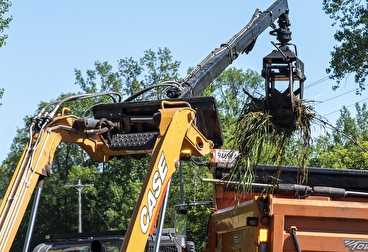
Problem: The Otter Tail County Highway Department needed a better way to clean out culvert debris (like tree branches, mud, rocks, plywood, and other garbage placed there by animals or people). With culverts ranging from 15 inches to 6 feet in diameter, there was no safe or efficient way to get this job done.
Solution: Highway maintenance workers developed the Otter Claw, an extendable culvert cleaner. This skid steer attachment extends up to 15 feet, allowing the operator to easily and safely remove large amounts of debris in as little as 10 minutes from previously hard-to-reach locations. The original design included a rotatable grapple claw fabricated from exhausted steel plow cutting edges—but the team broadened the tool’s functionality by developing additional hydraulic attachments for cleaning culverts, such as expandable paddle-like shovel heads and flat scraping heads to fit culverts of different sizes. Developing the Otter Claw cost $6,000.
Second Place: City of Bloomington, Sidewalk Snow Blower Castors
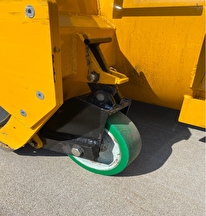
Problem: The City of Bloomington wanted a solution to the issues caused by its sidewalk snow blower shoes. On the maintenance side, the city crew needed to replace many of these shoes as they wore out—costing both work time and money for parts. The operators also had issues with the constant grating noise of the shoes, and occasionally there were injuries when a sidewalk heave would cause a sudden stop to the unit.
Solution: The maintenance crew decided to replace the snow blower shoes with castors. They tried a few different wheels before finding a style and material that worked well, and they fabricated the brackets with flat stock. Using castors on the city’s sidewalk snow blowing units has eliminated shoe wear, is quieter for the operators, and allows the machines to move safely over sidewalk heaves. The initial design took 15 hours, and the cost to fit eight units with the castors was $10,733 (including the prototyping).
Runner-Up: Big Stone County, Self-Performed Calcium Chloride
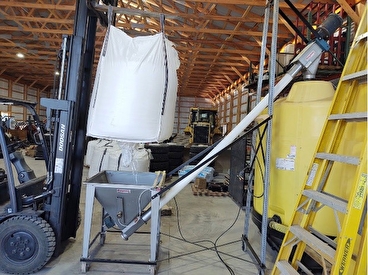
Problem: Calcium chloride (used for dust control on gravel roads) was not being applied in a timely manner in Big Stone County. One year it was applied after the Fourth of July holiday, causing unhappy residents. Additionally, cost for application was generally $0.10 to $0.15 per gallon higher than neighboring counties.
Solution: Two members of the Big Stone County Highway Department toured the operation of someone nearby who was mixing his own calcium chloride for dust control, ultimately deciding to adopt the same approach at the county. The department already had a 5,000-gallon stainless steel tanker truck and a smaller tank on an F-550—so the crew had a stainless-steel spray bar fabricated for each truck and purchased a mixing cone, gas pumps, valves, and tanks for mixing granular flakes into a liquid. When the mixing operation moved inside the new county maintenance shop, it was hardwired with an electric pump and plumbed to the municipal water system, and the mixing cone was replaced with a small auger and hopper. Dust control material can now be mixed when conditions are right, allowing for flexibility if applications need to be pushed back or paused due to weather conditions. Costs for the public are also lower than neighboring counties. The initial investment for the county was $10,000-15,000.
Runner-Up: Redwood County, Road Widener Improvements for Efficiency and Public Safety
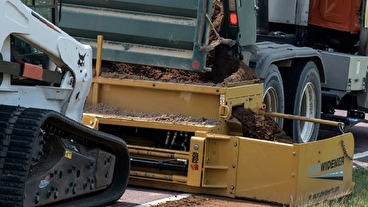
Problem: The Redwood County Highway Department had significant county-wide shoulder drop-offs, resulting in errant vehicle safety issues and unsupported pavement edges that needed correcting. The maintenance team needed equipment upgrades to efficiently do this work, as historically they had used a crew-made, belt-fed, gas-powered shouldering machine attached to a road grader. However, the weight of the machine caused unnecessary wear on the road grader tires, was incredibly heavy if hauled, and had frequent breakdowns due to its age.
Solution: The highway department purchased a remote-controlled, belt-fed, hydraulically operated road widener that can be attached to either a motor grader or skid loader. The crew found the new machine to be very efficient at placing gravel on two- to six-feet-wide shoulders, as it can be hydraulically adjusted for different widths. The new machine is much more agile and lightweight than the old one, though the county did have to hire a local welding shop to reinforce some of the widener’s parts after discovering issues with its truck box pins, discharge chute, frame, and belt two weeks into using it. The new road widener has allowed Redwood County to utilize over 50,000 tons of gravel per year (for both gravel roads and shoulders of paved roads)—up from just 15,000 to 20,000 tons of gravel per year. The approximate cost of welding the county’s new road widener parts was $6,262.
2022
First Place: City of Rochester, Plow Truck Pre-Wet Nurse Tank
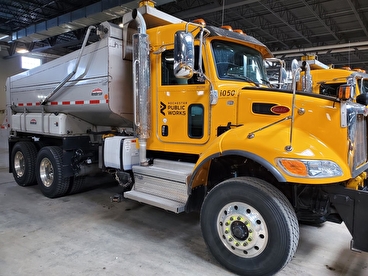
Problem: While standard practice for Rochester’s public works staff is to pre-wet their road salt at the spinner, their plow trucks only come with standard box-mounted saddle tanks. Once these tanks are less than half full, the brine sloshes around enough while driving that the control system will error out—resulting in the operator turning off the pre-wet and just applying dry salt for the remainder of their route.
Solution: The public works crew added a small nurse tank below the truck’s saddle tank. The saddle tank’s gravity feeds into this nurse tank and the brine pump draws out of this tank, pumping brine to the spinner—thus enabling complete use of all brine carried on the truck. Drivers are now able to apply salt through an entire plow event and also use less salt (since using pre-wet brine is proven to be as effective on roads using less material), which is beneficial both for the environment and the plowing budget. This modification cost about $1,778 in labor and materials.
Second Place (tie): Crow Wing County, Where's My Snowplow?
Problem: The highway department wanted an easier way for residents to check whether the county snowplows were out working, the locations of the plows, and whether specific roads had been plowed.
Solution: The county developed an app that would allow residents to see the location of snowplows and whether the roads they need to travel are plowed yet—allowing them to make safety-conscious decisions in real time. The Snow Removal Status app was developed by implementing software that pulls in GPS locations already existing on the snowplows, leveraging previous technological investments used throughout the county and eliminating the need to purchase new software.
Second Place (tie): Lake of the Woods County, Shear Attachment
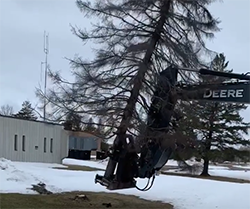
Problem: Clearing trees in the right-of-way using hand saws and chainsaws was both time-intensive and unsafe due to falling trees. It was also expensive to buy a logging equipment set-up for this purpose, only to use it for a short amount of time each year.
Solution: Lake of the Woods County purchased a used shear head from a logger and retrofitted it to attach to their excavator. It’s now much safer and faster for staff to remove trees or open rights-of-way.
Runner-Up: Crow Wing County, Sandbag Quick-Filler
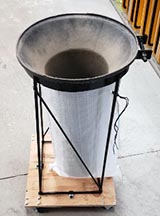
Problem: Filling sandbags typically takes two people: one to shovel in the material and one to hold the bag to accept the sand. One person can do it, but it is inefficient and cumbersome.
Solution: A county staffer had to fill sandbags by himself and knew he could develop a better way to complete the task more efficiently. Using existing and scrap materials including plywood, bolts, caster wheels, scrap metal, and a plastic sandbag chute, he developed a sandbag quick-filler that one person can use—saving both time and money in this work. If the county has a situation where they need to fill a large quantity of sandbags, they will have higher output and fewer people committed to the task.
Runner-Up: Crow Wing County, Pick A Mile
Problem: County residents often asked if there was a program for roadside cleanup and were disappointed to learn there wasn’t anything official. They were encouraged to clean roadside ditches and given bags and vests if available, but there was nothing in place to recognize these groups for their efforts or even track how many roadways were being cleaned annually.
Solution: After a passionate request from a resident in 2021, the highway department established a roadside cleanup program. Through the Pick A Mile link, residents can select the roadway they want to clean, request high-visibility safety vests and garbage bags, and choose a date for the pick to take place (so staff can quickly dispose of what is picked up). Volunteers are also recognized online, eliminating the need to maintain roadway signs. The county used already-existing software to develop this app, so there was no cost beyond staff time.
Runner-Up: Lake of the Woods County, Modified Bulldozer Blade
Problem: During large snow events, county staff use an excavator and open up ditches to prevent flooding in the spring. A normal excavator bucket gets filled with sticky, slushy snow and staff cannot compact the snowbanks. Additionally, the ditch is full of water, so workers are not able to put a bulldozer in the ditch.
Solution: Lake of the Woods County staff had an old blade from a bulldozer sitting around. They welded brackets onto it to make a quick attachment for the excavator. This modified blade makes it much faster and easier to open ditches that are full of slush and snow to prevent spring flooding.
2021
First Place: City of New Brighton, Skid Loader Attachment
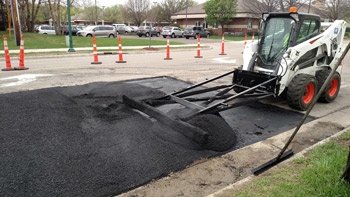
Problem: When dumping gravel and asphalt in smaller areas such as water main break sites, city staff were relying on a skid loader, shoveling, and a lot of hand luting to complete the job. This process was time- and labor-intensive and left a lot of material in the street to clean up.
Solution: The city purchased a skid loader attachment and modified it to allow workers to spread material faster, cleaner, and more evenly. Modifications included welding on a swivel plate, adding a hydraulic cylinder for leveling, creating and welding the tubing framework, and making screeds in different widths. It took 60 hours to create and cost about $1600. The attachment requires fewer workers, cuts the time it takes to do a job in half, and improves safety by helping keep workers out of traffic.
Second Place: Freeborn County, Step Extensions for Macks

Problem: County workers could not safely scrape ice off of or clean the windows of their Mack trucks. It was dangerous trying to climb up onto the tire, especially while parked on the side of the road with other vehicles driving by.
Solution: The county purchased factory steps from Mack and modified them to make extensions to the existing cab entry steps, allowing workers to more safely climb up onto the truck tires to clean their windows. The modification process required sheet metal, square tubing, a welder, and a band saw, and it cost approximately $200 per truck for materials. The step extensions will reduce the number of slips, trips, and falls that may have happened when workers were climbing on things that said “no step” or trying to pull themselves up onto the big tires.
Runner-up: Otter Tail County, Chip-Seal Marker Installation Tool
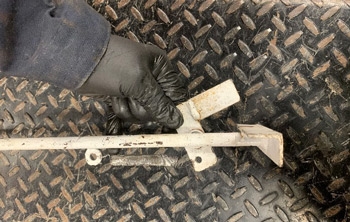
Problem: When installing chip-seal markers, county workers had to spend a lot of time getting on and off the tailgate of the pickup truck, walking down the road, and bending over to place each marker.
Solution: County staff created a chip-seal marker installation tool that allows one person to drive the pickup truck while another person in the back installs the chip-seal markers without getting off the tailgate. The tool took about one hour to fabricate and cost less than $20 in materials. Chip-seal markers can now be installed at a minimum of double the speed with the same number of workers.
2020
First Place: City of Plymouth, Underbody Removal Dolly
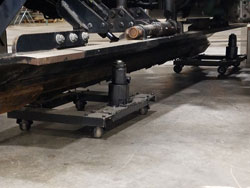
Problem: When removing or installing underbody blades on a truck, city staff needed to lift the vehicle with six mobile truck lifts. They also used a hydraulic table to lift and lower the blade when removing or installing the rods from the support tubes. This was usually a three-person job, and there were potential safety concerns using the table to remove or install the blade.
Solution: City staff developed a dolly system that allows trucks to stay on the concrete rather than being lifted up. The dolly system is used to lower the blade for removal, and then a bottle jack is used to take the pressure off the rods to pound them out. Once the rods are removed, staff can slide the dollies with the underbody blade out one side of the truck and put them away for storage. This new system is much safer and allows for a blade to be removed in roughly 45 minutes—half the time it took before.
Second Place: Jackson County Public Works, Mastic Box Wheel System
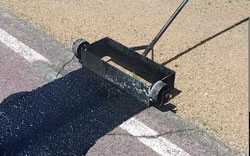
Problem: Large mastic boxes were too heavy for Jackson County staff to carry, so they were being dragged down the pavement, leaving a messy trail of product on the roadway.
Solution: Staff added a set of wheels to the mastic boxes, making it easier to move them between cracks on the roadway and keeping product from spilling out onto the road. Benefits of the project, which was completed using mainly leftover materials from other jobs, include minimized waste of product and reduced staff fatigue.
Runner-up: Crow Wing County Highway Department, Emergency Sign Skid
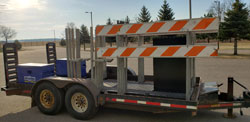
Problem: When road emergencies happen (water over the road, washouts, storm damage, crashes, etc.), the highway department needs to deploy signs quickly to the scene. The department's past practice was to load barricades and specific signs into a truck, load up sandbags to hold the signs in place, gather flashing lights or other accessories for each specific need, and then dispatch to the emergency. This took a lot of time to assemble, and the delay raised the public safety risk.
Solution: Crow Wing County staff came up with an idea for an emergency sign skid that could quickly be loaded onto a trailer or into the back of a truck for faster and more efficient responses. The emergency sign skid is pre-loaded with signs, sandbags, and accessories. One person can quickly load the skid and dispatch to the scene.
2019
First Place: City of Rochester, Manhole Ring Lifter
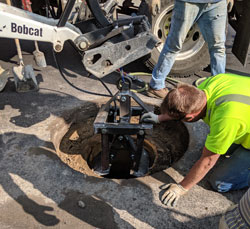
Problem: The city's Public Works Department rebuilds all manholes (about 500 per year) needing repairs and replacement during street improvement projects. During this process, employees stand on the street and remove concrete rings with jackhammers before manually lifting the broken pieces to street level. This work involves hours of extensive bending and lifting. Additionally, the task of cutting and jackhammering concrete rings exposes crews to silica dust.
Solution: The manhole ring lifter, a hydraulic lifting device that is attached to a crane on a truck, was designed to mechanize the removal of concrete rings. The lifter is first lowered by the crane into the manhole; then, a set of wings are extended to dislodge the ring and lift it to the surface of the street. This device eliminates the need for jackhammering and the manual labor of bending and lifting.
Second Place: Olmsted County Public Works, 360-Degree Camera Culvert Inspection
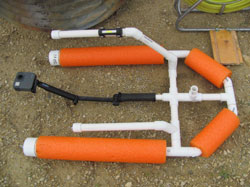
Problem: Olmsted County has over 1,600 centerline culverts that need to be inspected and maintained. To eliminate the need for staff to manually crawl through culverts, the county wanted to build a remote-controlled car similar to MnDOT's HIVE. However, there were some concerns about the HIVE design that the county wanted to improve upon to better serve its needs and systems.
Solution: The county constructed two sleds out of PVC piping, one of which includes floats for culverts containing water. The sleds each hold a 360-degree waterproof camera and lights, and they can be pulled through culverts with reel-mounted fiberglass fish tape. The camera records the whole culvert during the inspection, which allows staff to view any area of concern from multiple viewpoints to analyze if repair is required. Overall, the inspection tool has improved safety for inspectors and removes the need for staff to make decisions in the field because the recorded video can be analyzed at any time.
Runner-up: Crow Wing County Highway Department, Standardized Mailbox Support Tool
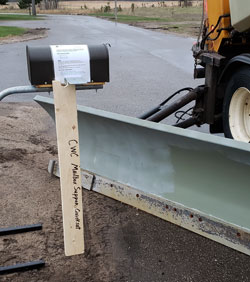
Problem: With more than 60,000 residents and 26,000 homes in the county, the highway department was encountering mailbox supports being set at varying heights. This caused problems when plowing snow; the wing plow could be used to clear snow under some mailbox supports, but not others.
Solution: The county's maintenance specialist made eight identical four-foot boards for measuring the height of mailbox supports. The boards were distributed internally and to mailbox support contractors working on the county's road projects to ensure that all who install or repair these supports are setting them to the same height. Standardizing heights means that fewer supports are hit by plows, ultimately saving the county money in replacement costs and causing fewer disruptions for residents.
Runner-up: Douglas County Public Works, Excavator Mower Attachment
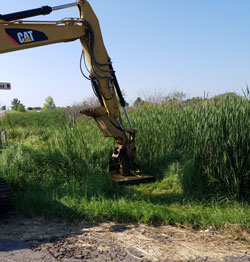
Problem: Public Works staff were unable to reach high overhanging branches and had to borrow equipment to mow cattails and overgrown willows in wet areas.
Solution: County mechanics used an old diamond mower deck to make a quick attachment that can be used on an excavator. The attachment allows staff to mow and clear unwanted vegetation that impedes visibility at intersections and eliminate overhanging branches on county roadways.
2018
First Place: Otter Tail County Highway Department, Otter Plow Cushion

Problem: Winter roads, especially late in the season, can be especially rough, causing more stress on snowplow lift chains and plow lift parts as the heavy plow assembly bounces more. Broken plow lift chains are a common result and can take maintenance vehicles and personnel out of service for hours.
Solution: Maintenance personnel with Otter Tail County Highway Department created the Otter Plow Cushion with spare parts during downtime on a cold winter day. The device absorbs the shock of rough roads on the plow assembly and lift chains, improving ride quality and reducing the failure of the plow lift chains and parts. Once their stock of used parts was depleted, the department maintenance staff found they could purchase the needed parts new for about $431 per plow.
Second Place: City of Rochester Public Works Department, Hydraulic Arrow Board
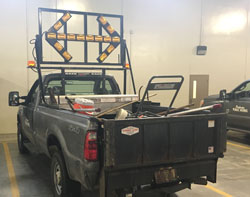
Problem: The city's infrastructure maintenance crew members had to climb into the back of the truck and physically lift/lower the electronic arrow board into position. The arrow board has to be lowered before moving to a new worksite in order to avoid it being caught in low-hanging trees.
Solution: The arrow board is now raised and lowered by a hydraulic pump operated from inside the vehicle. This eliminated the need for staff to climb into the back of the truck to raise and lower the board manually. Additionally, the new system allows the arrow board to be raised 18 inches higher than before, making it more effective at traffic control because it's more visible.
2017
First Place: Clearwater County Highway Department, Tractor-Mounted Shouldering Box
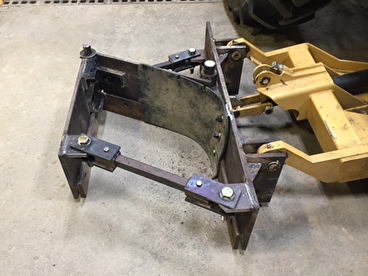
Problem: After spring road restrictions and before the county begins its normal summer road maintenance, staff fill the slow period by shouldering the county's roads using available equipment. In the past, the county has added a shoe to the end of the moldboard on the motor grader or to the end of the wing on a plow truck to accomplish this task. However, using this equipment took away from production and other maintenance activities.
Solution: The county fabricated a tractor-mounted shouldering box, which allowed the county's motor grader operators to remain on their regular blade routes without interruption and freed up a truck to haul shouldering material. As an added benefit, the box of the tractor-mounted unit keeps gravel material on the shoulder with minimal spill onto the roadway. Savings achieved included enhanced visibility, minimal cleanup, increased speed due to visibility, and increased safety for the traveling public.
Second Place: Polk County, Asphalt Patch Trailer Improvements for Safety and Productivity
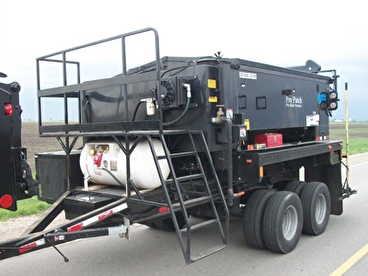
Problem: Members of the county's patch trailer crew had no safe way to load tack oil into the top of the machine without climbing on the trailer tongue and then the propane fuel tank to reach the fill port. In addition, the tack oil dispensing wand was too short to reach more than one lane of the road surface without positioning the truck/trailer between both lanes of traffic on two-lane roads.
Solution: County staff designed and fabricated a platform with an access stairway that allows workers to safely maintain three points of contact while ascending and descending the platform to perform required duties, including filling the tack oil tank, monitoring asphalt material hopper levels, and servicing the tack oil pump. Staff also designed and fabricated a swinging boom to support the added weight of the extended tack oil dispensing wand to reduce operator fatigue and provide an extended reach for two lanes of traffic and roadway shoulders. The boom also prevents the excess hose from lying on the roadway, thereby eliminating tripping/entanglement hazards for the other workers on the patch crew.